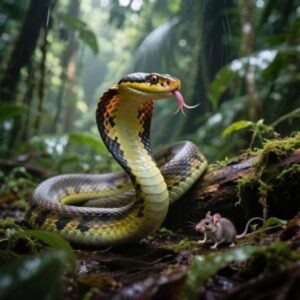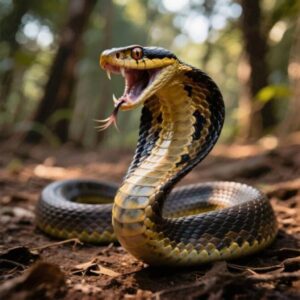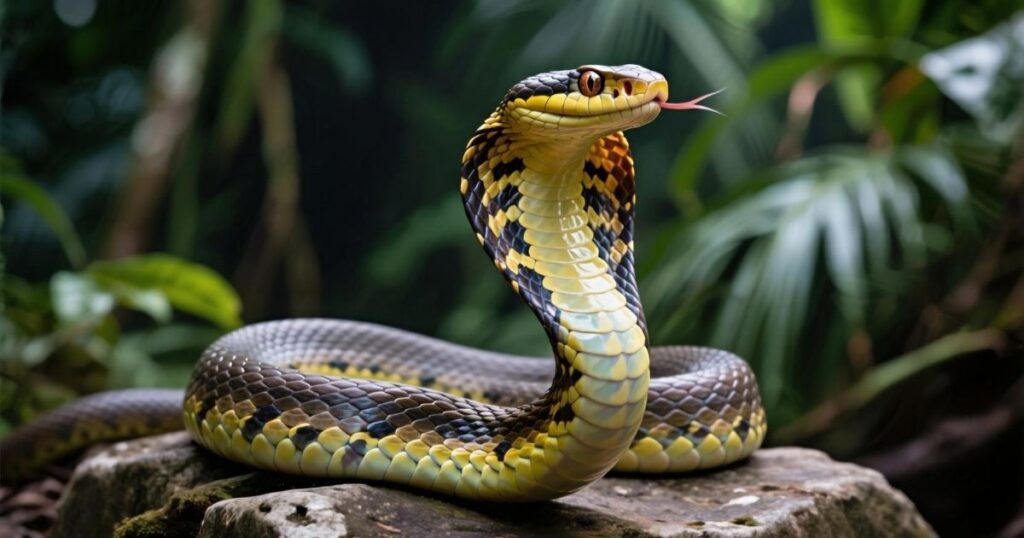The King Cobra is one of the most famous snakes in the world. This cobra snake is known for its power, speed, and deadly venom. People often fear king cobras because of their large body and hood spreading. They are the longest venomous snakes and can grow very big. The King Cobra can reach an incredible king cobra size of up to 18 feet. That makes it an apex predator in the wild.
The king cobra habitat stretches across forests, mangroves, and grasslands in Asia. They live in countries like India, Thailand, and Indonesia. These snakes hunt other snakes, making them different from many species. King cobras are strong, smart, and dangerous when threatened. They raise their body high and show a threat display to scare enemies. This cobra snake plays an important role in nature. Learning about their habitat, size, and behavior helps us respect and protect them.
Etymology
The name King Cobra comes from its status as the largest venomous snake in the world. Its scientific name, Ophiophagus hannah, was given by Danish scientist Theodore Edward Cantor in 1836. The word Ophiophagus means “snake-eater,” showing its unique diet of hunting and eating other snakes.
The term hannah in its name links to the Greek word meaning “flower” or sometimes interpreted as “tree-dweller,” reflecting its forest habitat. Unlike the common Indian cobra (Naja naja), the King Cobra belongs to its own genus Ophiophagus within the family Elapidae. This highlights its distinct identity in snake classification.
Taxonomy
The King Cobra belongs to the family Elapidae, which includes cobras, kraits, and mambas. Its scientific name is Ophiophagus hannah. The word “Ophiophagus” means “snake-eater,” showing its habit of feeding on other snakes. Unlike other cobras, it stands alone in its own genus, making it unique.
Scientists have studied the classification of this cobra snake for many years. Some earlier studies placed it with the genus Naja (true cobras). However, genetic research confirmed that king cobras are different enough to require their own group. This discovery highlights how special their evolution is among venomous snakes.
The closest relatives of the king cobra include species like the banded krait, Indian cobra, and mambas. All belong to the Elapidae family. These snakes share traits like fixed front fangs and potent venom. Yet, the king cobra’s size, behavior, and snake-eating diet set it apart from the others.
Synonyms
When people talk about the King Cobra, they often use different names. Its scientific name is Ophiophagus hannah. Some call it the “hamadryad,” which is an old word still used in books and studies. These synonyms show the many ways people know and describe this cobra snake.
The word Ophiophagus means “snake-eater,” which fits perfectly because king cobras often prey on other snakes. That’s why in some places, locals also refer to them as “snake-eating cobras.” These synonyms highlight their special feeding behavior, unlike other cobra snake species.
In India, people sometimes use “Indian king cobra” to separate it from the Indian cobra (Naja naja). While both belong to the family Elapidae, they are very different. This synonym helps people understand the distinction, especially when studying king cobra habitat and king cobra size.
Another common synonym is “giant hooded snake.” This comes from the way the king cobra spreads its hood during a threat display. Villagers in Southeast Asia often describe it this way in stories and folklore. Such synonyms show the cultural significance of king cobras in local communities.
In scientific research, synonyms like “hamadryad snake” and “Ophiophagus” are still widely used. Researchers include them in studies about venom, clinical management, and conservation. Knowing these synonyms is important for identifying the species correctly across different regions and languages, from Myanmar to the Philippines.
Today, databases like the IUCN Red List and CITES Appendix II also list these synonyms for clarity. This ensures global protection laws cover the same species, no matter the name used. Whether you call it hamadryad, snake-eating cobra, or King Cobra, it remains one of the most powerful snakes on Earth.
Read More: What Does It Mean When a Bird Hits Your Window?
Evolution
The evolution of the king cobra is a fascinating story. Scientists believe this cobra snake belongs to the family Elapidae, which includes mambas and kraits. Fossil records suggest snakes like the king cobra evolved millions of years ago. Over time, their venom became more complex, helping them survive as apex predators.
Unlike many snakes, king cobras developed unique traits. Their hood spreading and threat display evolved to warn rivals and enemies. Their diet also shaped their evolution, as they mainly eat other snakes like rat snakes and kraits. Modern research on king cobra DNA shows adaptations for venom, hunting, and even reproduction.
Distribution and habitat
The King cobra is found across South and Southeast Asia. Its range covers India, Bangladesh, Bhutan, Nepal, Myanmar, and Sri Lanka. You’ll also see it in Thailand, Malaysia, Indonesia, Vietnam, Cambodia, Laos, Singapore, and southern China. This wide spread makes it one of Asia’s most recognized venomous snakes.
King cobras prefer warm and humid regions. They live near rivers, wetlands, and dense forests. In India, they are often seen in the Western Ghats, Eastern Ghats, Terai region, and the Sundarbans. They even occur on the Andaman Islands. Their presence across so many regions shows their adaptability.
The king cobra habitat includes tropical rainforests, bamboo thickets, and mangrove swamps. These areas give them cover and plenty of prey like other snakes. They are often found in undisturbed natural spaces where they can hunt quietly. Good habitat is vital for their survival, as it provides food and protection.
However, king cobras can also adjust to agricultural lands and human settlements when forests shrink. Sadly, this increases conflict with people. Loss of habitat due to farming, deforestation, and urban growth puts pressure on their population. Protecting natural forests and wetlands is crucial to keep these snakes safe in the wild.
Behaviour and ecology
The king cobra is active during the day and often moves through forests in search of prey. Unlike many snakes, it mainly eats other snakes, including rat snakes and pythons. It uses its forked tongue and Jacobson’s organ to track scents. King cobras are shy but can turn aggressive when disturbed.
In their natural habitat, king cobras play an important role as apex predators. They control snake populations and balance the ecosystem. During the breeding season, females build nests, which is rare among snakes. They guard their eggs fiercely until hatching. King cobras also display hood spreading and loud hissing as a threat display.
Diet

The diet of the king cobra is unique compared to most snakes. It mainly eats other snakes like rat snakes, pythons, and kraits. This makes it a true snake-eater, also called “Ophiophagus.” Sometimes, it may hunt small lizards like the clouded monitor, but snakes remain its favorite food.
King cobras are skilled hunters with sharp senses. Using their forked tongue and Jacobson’s organ, they track prey with precision. They can go weeks without food after a big meal. In the wild, this hunting style helps control snake populations. Their diet keeps balance in the king cobra habitat.
Antipredator behavior

King cobras use several smart tactics to avoid danger. Their most famous is hood spreading, where they raise their head high and flare their hood. This makes the snake look bigger and scarier. The display warns predators to back off. It’s a clear sign of strength and defense.
Another strong antipredator behavior is hissing. The king cobra produces a low growl-like sound using its tracheal diverticula. Unlike most snakes, this growl is deep and loud. It warns attackers before the snake strikes. This sound helps scare away animals, including humans, without wasting venom.
King cobras may also use striking as a last defense. If the threat doesn’t move, the snake delivers a quick bite with strong venom. The bite can cause paralysis and even death. Predators usually avoid fighting once they know the danger of a cobra snake bite.
Sometimes, king cobras prefer escape over attack. They can move fast and slide into thick vegetation or burrows. In their natural king cobra habitat, quick retreat saves energy and avoids injuries. This shows that defense isn’t always about fighting but also about survival. It’s a smart survival strategy.
Reproduction

King cobras usually reproduce during the warmer months, often between January and April. This is their breeding season when males search for females. Courtship includes body movements and following the female closely. Once mating happens, the female prepares herself for laying eggs in the coming weeks.
A female king cobra can lay between 20 and 40 eggs in one season. That’s more than most cobra snake species. The eggs are oval in shape and covered with a soft shell. Their average size is about two inches long.
What makes king cobras unique is how they care for their eggs. Unlike many snakes, the female builds a nest using leaves and soil. She places her eggs inside this safe nest. Then she guards them fiercely.
The incubation period usually lasts around 60 to 80 days. During this time, the eggs need a steady warm temperature. On average, they require about 28 to 30 °C to develop properly.
Once the eggs hatch, tiny king cobras emerge fully equipped with venom. These hatchlings are around 18 to 22 inches long. Even though they are small, they can protect themselves right away. The mother leaves after hatching, and the young must survive on their own.
Venom
The venom of a king cobra is powerful and complex. It contains three-finger toxins (3FTx), alpha-neurotoxins, cytotoxins, beta-cardiotoxins, haemorrhagins, and ohanin. These cause neurotoxicity, tissue necrosis, and sometimes respiratory failure. Unlike many snakes, king cobra venom is not the strongest by drop, but it delivers large amounts, making it deadly.
Composition
The venom of the king cobra is a powerful mix of different toxins. It contains three-finger toxins (3FTx), snake venom metalloproteinases (SVMPs), alpha-neurotoxins, cytotoxins, beta-cardiotoxins, haemorrhagins, and a unique protein called ohanin. Each of these plays a role in causing pain, paralysis, and sometimes even respiratory failure.
Scientists continue to study king cobra venom because of its medical value. Research shows it can affect nerves, muscles, and blood. Some components are being tested for new medicines, like painkillers and treatments for heart problems. Even though it’s deadly in nature, understanding its composition may help doctors create life-saving therapies and better antivenom.
Clinical management
Clinical management of king cobra bites begins with quick medical care. The bite delivers powerful venom that can cause respiratory failure, tissue necrosis, and severe neurotoxicity. Doctors first stabilize the patient’s breathing and circulation. Supportive care is crucial before antivenom is given. Early hospital treatment increases the chances of survival.
Antivenom is the most important step in clinical management. Equine origin antivenom, developed by institutes like the Haffkine Institute, King Institute of Preventive Medicine and Research, and Thai Red Cross Society, is widely used. It helps neutralize toxins such as three-finger toxins (3FTx), alpha-neurotoxins, and cytotoxins. Proper dosage prevents worsening of symptoms.
Besides antivenom, doctors monitor for complications. Patients may need ventilators if breathing stops or surgical care if tissue necrosis spreads. Regular observation helps manage pain and infection. Effective clinical management requires both immediate emergency response and ongoing medical support to reduce long-term damage and save lives.
Relationship with humans
The king cobra often sparks fear because of its venom and size, but it rarely attacks unless provoked. Many bites happen when people accidentally disturb it. Farmers, snake charmers, and locals living near king cobra habitat sometimes encounter these snakes. Still, they usually avoid humans whenever possible.
In some regions, king cobras hold cultural and religious importance. They appear in Hindu mythology and local rituals, symbolizing power and protection. Sadly, human activities like deforestation, hunting for snake leather, and wildlife smuggling threaten them. Conservation laws, antivenom research, and awareness programs now aim to protect both people and king cobras.
Conservation
Conservation of the King Cobra is very important because this cobra snake is listed as Vulnerable on the IUCN Red List. The king cobra habitat is shrinking due to deforestation, urban growth, and farming. Snake leather trade and wildlife smuggling also put heavy pressure on wild king cobras.
To protect them, many countries like India, Thailand, and Indonesia have strong laws. The Wildlife Protection Act, 1972 (India) and Republic Act No. 9147 (Philippines) safeguard the species. Conservation groups work on saving forests, stopping illegal trade, and educating locals. Protecting the king cobra habitat ensures survival for future generations.
Cultural significance
The King Cobra holds a powerful place in culture and tradition. In India, it is seen as sacred and is linked with Lord Shiva. Cobra snake rituals and festivals show respect for this creature. Cobra tattoos also symbolize strength and protection in many Asian societies.
Across Southeast Asia, king cobras are part of local myths and beliefs. In Myanmar, the Pakokku clan worships them through snake rituals. Shrines like the Rama II Road shrine in Bangkok honor their presence. These traditions highlight the deep respect people have for the king cobra and its spiritual meaning.
FAQ’S
What is the largest size this snake can reach?
The King Cobra can grow up to 18 feet, making it the longest venomous snake. Its impressive size helps it dominate as an apex predator.
Where can this snake usually be found?
The King Cobra lives in forests, mangroves, and grasslands across Asia. Its habitat includes India, Thailand, Indonesia, and other Southeast Asian countries.
What does this snake mainly eat?
The King Cobra prefers to hunt other snakes, including rat snakes and pythons. This unique diet sets it apart from many other venomous reptiles.
How dangerous is this snake to humans?
The King Cobra has powerful venom that can cause respiratory failure. Its threat display warns humans to stay away, reducing the chances of attacks.
Is this snake protected by law?
The King Cobra is listed as Vulnerable on the IUCN Red List. Laws like India’s Wildlife Protection Act, 1972 help in conserving this species.
Conclusion
The King Cobra is more than just a cobra snake with deadly venom. It is an apex predator that keeps balance in the wild. The king cobra habitat spreads across forests, wetlands, and grasslands in Asia. Its large body and hood spreading make it a powerful sight. With a king cobra size reaching 18 feet, it is the world’s longest venomous snake. This makes the King Cobra unique among reptiles.
King cobras are often feared, yet they also hold deep cultural importance. They appear in rituals, myths, and beliefs in many Asian countries. Protecting these snakes is vital as they face threats from hunting, habitat loss, and wildlife smuggling. By respecting their role in nature, we protect biodiversity and traditions too. The king cobra habitat must be preserved, and awareness must grow. This cobra snake remains a symbol of strength, mystery, and survival in the natural world.


1 thought on “King cobra”